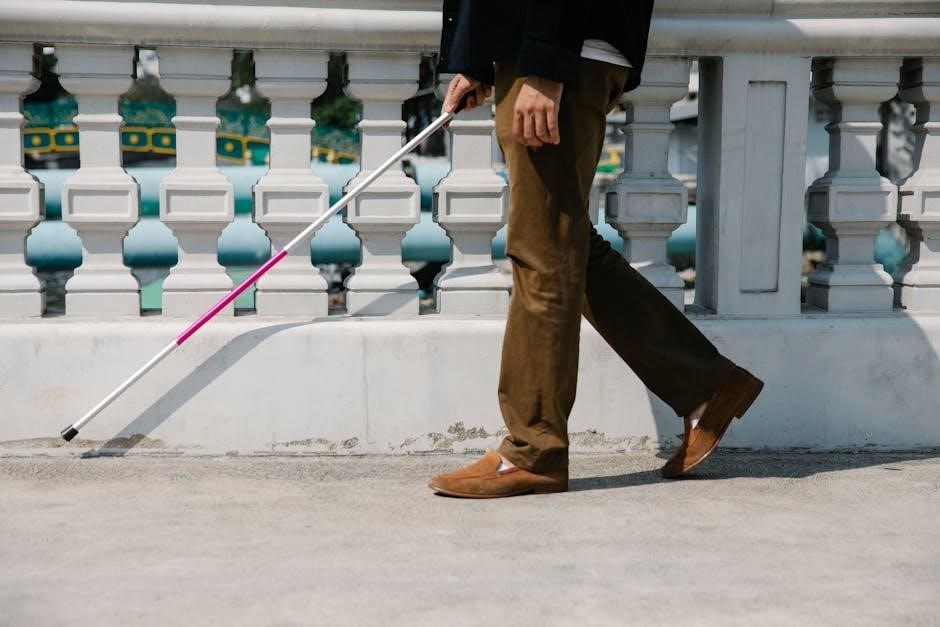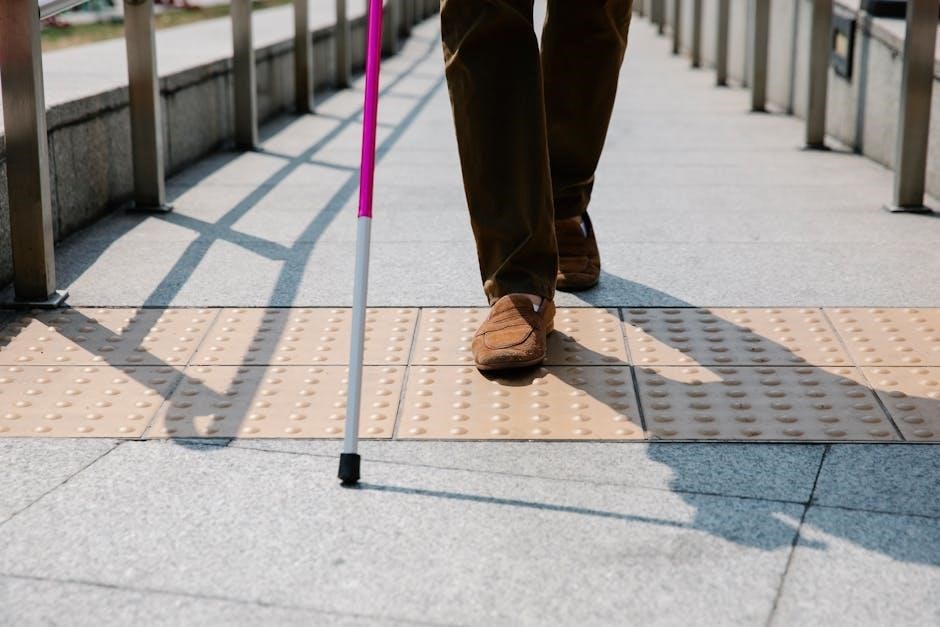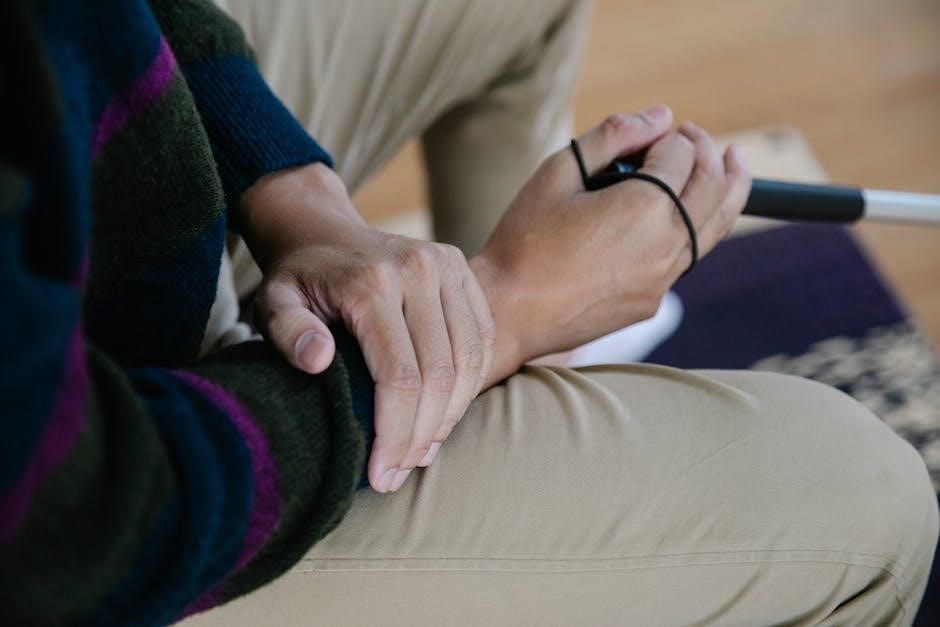A guide cane is a mobility aid designed to provide support and balance, helping users navigate safely. It is commonly used by individuals with visual impairments or those needing stability while walking, offering a simple yet effective tool for greater independence and confidence in daily life.

1.1 What is a Guide Cane?
A guide cane is a mobility aid designed to assist individuals, particularly those with visual impairments, in navigating their surroundings. It is typically a long, white stick that extends to the user’s height, enabling them to detect obstacles and move safely. The white color of the cane serves as a visual indicator to others, signifying the user’s visual impairment. Guide canes are essential tools for independence, providing both support and balance. They come in various types, such as folding and adjustable models, catering to different needs and preferences. Proper use involves techniques like placing the cane next to the good leg and synchronizing its movement with the user’s steps. Understanding the correct usage and etiquette ensures effective and confident mobility for users.

1.2 History and Evolution of Guide Canes
The history of guide canes dates back to ancient civilizations, where sticks were used for navigation and support. In the 20th century, the white cane became a universal symbol for visual impairment, standardized to enhance visibility and recognition. Over time, advancements in materials and design have led to more durable and adjustable options, such as folding canes, improving portability and ease of use. The development of specialized tips and ergonomic handles has further enhanced functionality. Organizations worldwide have played a significant role in promoting the use and acceptance of guide canes, ensuring they remain a vital tool for independence and mobility.

Types of Guide Canes
Guide canes come in various forms, including white canes for visual impairment, folding canes for portability, and specialty canes tailored to specific mobility or sensory needs.
2.1 White Canes for Visual Impairment
White canes are essential tools for individuals with visual impairments, aiding navigation and obstacle detection. Typically long and white, they assist users in identifying surroundings, signaling visual impairment to others, and ensuring safe movement. Training is often required for effective use, emphasizing techniques to sweep areas and detect hazards. The white cane is both practical and symbolic, representing independence and accessibility for visually impaired individuals, helping them navigate environments confidently and safely while also raising awareness among the public about their needs and rights.
2.2 Folding and Adjustable Canes
Folding and adjustable canes offer versatility and convenience for users with varying mobility needs. These canes can be easily folded for storage, making them portable and ideal for travel. Adjustable canes allow users to customize the height to suit their comfort and posture, ensuring proper alignment and support. They are lightweight yet durable, catering to individuals who need temporary or occasional assistance. Their compact design and adaptability make them a practical choice for those who value ease of use and flexibility in their daily lives, providing reliable support without compromising on convenience.
2.3 Specialty Canes for Specific Needs
Specialty canes are tailored to address unique mobility challenges, offering targeted solutions for specific conditions. For instance, quad canes provide enhanced stability with their wide, four-legged base, making them ideal for users with severe balance issues. Shock-absorbing canes are designed for individuals with arthritis or joint pain, reducing impact on joints. Additionally, canes with GPS or tactile feedback cater to visually impaired users, aiding navigation. These specialized designs ensure that users with distinct needs can find a cane that meets their requirements, fostering independence and confidence in their daily activities while providing the necessary support and functionality.

How to Choose the Right Guide Cane
Selecting the right guide cane involves considering your mobility needs, the level of support required, and personal comfort. The ideal cane enhances stability, independence, and confidence.
3.1 Measuring for the Correct Height
Proper height measurement is essential for effective use of a guide cane. Stand upright with shoes on and the cane by your side. Adjust the cane so the handle reaches the top of your thigh. Ensure a slight bend in your elbow, typically 15-30 degrees, to maintain proper posture. This ensures the cane provides adequate support without causing strain. For white canes, the tip should extend just past your feet when standing. Adjustable canes allow customization, while folding canes may require precise sizing. Correct height ensures balance, stability, and comfort, maximizing the cane’s ability to assist with mobility and navigation.
3.2 Selecting the Right Grip and Handle
Selecting the right grip and handle for your guide cane is crucial for comfort and usability. Ergonomic grips, such as contoured or cushioned handles, reduce strain on the hand and wrist. Functional grips with a straight handle perpendicular to the shaft offer better support. Consider materials like foam, gel, or rubber for shock absorption and a secure hold. The handle should fit naturally in your hand, allowing you to maintain proper posture and control. Testing different styles can help determine the most comfortable option. A well-chosen grip ensures prolonged use without discomfort, making the cane a reliable and effective mobility aid tailored to your specific needs and preferences.
3.3 Understanding Cane Tips and Their Uses
Cane tips play a critical role in stability and traction, ensuring safe and effective use of a guide cane. The most common type is the rubber tip, which provides excellent grip on various surfaces. Quad tips, with four points of contact, offer enhanced stability and are ideal for users needing additional support. Specialty tips, such as metallic or spiked tips, are designed for specific terrains like ice or uneven ground. Choosing the right tip depends on the user’s mobility needs, environmental factors, and personal preference. Regularly inspecting and replacing worn tips is essential to maintain safety and performance, ensuring the cane remains a reliable mobility aid.

Using a Guide Cane Correctly
Start with the cane next to your good leg, then move it forward with your weak leg. Keep the tip firmly on the ground for stability.
4.1 Proper Walking Technique with a Cane
Start by standing upright with the cane a small step in front and to the side of your weaker leg. As you step forward with your weaker leg, move the cane simultaneously, keeping the tip firmly on the ground. Maintain a relaxed grip, not too tight or loose, and keep your elbow slightly bent for shock absorption. Adjust the cane height so your forearm is parallel to the ground, allowing natural arm movement. When turning, shift your weight and pivot with the cane, ensuring it moves in sync with your steps. Regular practice will help you develop a smooth rhythm, making cane use feel natural and intuitive over time.
4.2 Navigating Stairs and Uneven Surfaces
When navigating stairs with a guide cane, place the cane tip on each step before stepping down. Descend one step at a time, holding onto the handrail if available. For uneven surfaces, sweep the cane from side to side to detect obstacles. Move slowly, ensuring the cane tip stays in contact with the ground. On inclines, keep the cane close to your body for better balance. Always prioritize caution and use additional support, like handrails, when possible. Practice these techniques to build confidence and adapt to challenging environments effectively while using your guide cane.

Guide Cane Etiquette and Safety
Respect personal space when interacting with others using a guide cane. Avoid touching their cane without permission. Be mindful of crowded areas and use your cane responsibly.
5.1 Interacting with Others While Using a Cane
When using a guide cane, it’s important to maintain confidence and independence. Respect personal space and avoid unnecessary physical contact with others. Communicate clearly if assistance is needed, but never feel obligated to accept unsolicited help. Be mindful of cultural differences and social norms, as reactions to cane use can vary. If someone offers support, respond politely, such as saying, “Thank you, but I’ve got this.” Avoid apologetic behavior for using a cane, as it is a tool for empowerment. Remember, your cane is an extension of you, and it’s okay to rely on it in public settings. Stay calm, assertive, and patient when interacting with others.

5.2 Safety Tips for Public Use
When using a guide cane in public, prioritize visibility and awareness. Wear reflective or bright clothing to enhance visibility, especially at night. Ensure your cane is in good condition, with secure joints and a sturdy tip. Avoid crowded areas if possible, and use accessible pathways. Stay alert to obstacles like uneven surfaces or loose objects. When navigating stairs, hold the handrail and move step-by-step. Always keep your cane within reach when sitting. Be cautious of distractions like loud noises or sudden movements. Use crosswalks and follow traffic signals to ensure safe crossing. By staying vigilant and prepared, you can navigate public spaces confidently and safely.

Maintaining and Accessorizing Your Guide Cane
Regularly clean your guide cane with a damp cloth and store it in a dry place to prevent damage. Customize with reflective materials for increased visibility and safety. Consider adding grips or handles for better comfort and traction.

6.1 Cleaning and Storage Tips
Regular cleaning and proper storage are essential for maintaining your guide cane. Use a damp cloth to wipe down the cane, avoiding harsh chemicals or abrasive materials that could damage the surface. For tougher stains or dirt buildup, mix mild soap with water and gently scrub the area. After cleaning, dry the cane thoroughly to prevent moisture from affecting its structure. Store your cane in a dry, cool place, away from direct sunlight. If possible, keep it upright or hang it to avoid bending or warping. Consider using a protective cover for the tip to prevent wear and tear during storage.
6.2 Customizing Your Cane for Comfort
Customizing your guide cane can enhance comfort and personal preference. Consider adding ergonomic handles made from materials like foam or gel for better grip and reduced fatigue. Adjusting the height to fit your posture ensures proper alignment and reduces strain on the shoulders and wrists. Some users prefer adding reflective tape or bright colors for increased visibility. You can also personalize your cane with engravings or decorative wraps to match your style. Additionally, interchangeable tips allow you to adapt your cane for different terrains, such as rubber tips for smooth surfaces or spike tips for outdoor use. These customizations ensure your cane feels tailored to your needs and preferences.